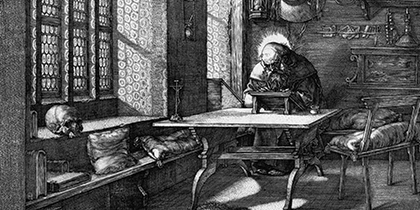
March 27, 2015, by Guest blog
Early Modern Medievalism: The End or Creation of the Middle Ages?
Post by Dr Mike Rodman Jones, School of English
Albrecht Durer’s St Jerome in his Study (1513) is a seminal work in Renaissance art history. It is also one that, in its subject, execution, and reception, divides cultural time in a way that both omits and contains the Middle Ages. St Jerome (d. 420) appears here as an early modern scholar, much in the way that Holbein would represent Erasmus of Rotterdam (1523). The architectural detail and Durer’s interest in rendering the perspective of the domestic interior place this image at a particular moment in cultural history: the epochal moment of the Renaissance, the moment at which the Middle Ages becomes “early Modernity”. Jerome is also ensconced in the process of biblical translation, an activity with sharply politicised and often violent associations in the Sixteenth Century. At the same time, it was Jerome’s translation of the Bible (the ‘Vulgate’) that was one of the central cultural phenomenon of the European Middle Ages, a text cited, discussed, quoted, and debated in everything from Thomas Aquinas’ Summa Theologia to William Langland’s Piers Plowman. More details of the engraving direct us back to medieval clerical and vernacular cultures. The lion in the foreground is amongst the most famous icons of hagiographical narrative associated with works like Jacobus de Voragine’s Golden Legend. Jerome’s cardinal’s hat hanging from the wall recalls another essential aspect of Jerome’s legend, his frequently illustrated position in the upper hierarchy of the Roman Catholic Church. Durer’s engraving, then, might be seen to be quintessentially “medieval”, even as it is often viewed and discussed as an important cultural product of the “Renaissance”.
But when, really, did the Middle Ages end?
There is much at stake in the answer to this seemingly innocuous question. It is striking, for example, that my use of the terms “medieval” and “Renaissance” above adheres to the modern typological convention of capitalising the terms “Renaissance” (and indeed often “Modern”) while not doing the same for “medieval”. Such an apparently minute thing is in fact indicative of a broader understanding of cultural history, one that allows even the most culturally-literate to frequently use the term “medieval” as a synonym for ‘barbaric’ or ‘uncultured’ (for an example of this, see the recent controversy over Salman Rushdie’s use of the term in a piece for the TLS):
Traditionally, the answer is a fairly straightforward “somewhere around 1500”. In more detailed ways, we might look to changes in scholarly culture, religious identity, textual production or linguistic standardization to answer this question. In England, we might think of the Reformation, the arrival of print from the continent in the 1470s, the rise of “Renaissance Humanism”, the loss of dialectical difference and most residual inflections in English.
However, we might also look directly at the sixteenth century as one that did not, perhaps, witness the ‘end’ of the Middle Ages so much as the first construction of it, the first wave of selective cultural appropriation and amnesia which rendered the ‘medieval’ as we might (try not to) see it.
The Institute for Medieval Research is hosting an afternoon’s symposium 15 May of particular interest to researchers and postgraduate students in Medieval Studies, early Modern Studies, English, History and History of Art.
No comments yet, fill out a comment to be the first

Leave a Reply